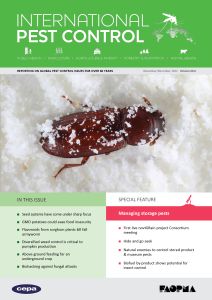Not known Facts About Eco Bed Bug Exterminators Dc
Table of ContentsThe Best Guide To Eco Bed Bug Exterminators DcNot known Details About Eco Bed Bug Exterminators Dc Eco Bed Bug Exterminators Dc - TruthsFacts About Eco Bed Bug Exterminators Dc UncoveredGetting My Eco Bed Bug Exterminators Dc To Work
Due to the fact that chemicals are poisonous, they are likewise potentially dangerous to people, pets, other microorganisms, and the atmosphere. For that reason, people that utilize pesticides or consistently can be found in call with them need to recognize the loved one toxicity, potential health results, and preventative measures to decrease exposure to the products they utilize. Hazard, or threat, of utilizing pesticides is the possibility for injury, or the degree of danger involved in making use of a chemical under a provided set of conditions.
Nevertheless, applicators can decrease or virtually eliminate exposure-- and therefore decrease hazard-- by adhering to the tag directions, using individual protective apparel and equipment (PPE), and dealing with the pesticide effectively. As an example, even more than 95 percent of all pesticide direct exposures come from facial exposure, largely to the hands and forearms. By putting on a pair of unlined, chemical-resistant handwear covers, this type of exposure can be virtually gotten rid of.
The hazardous effects that occur from a single direct exposure by any route of entrance are called "intense effects." The four paths of exposure are dermal (skin), breathing (lungs), dental (mouth), and the eyes. Severe poisoning is determined by taking a look at the dermal poisoning, inhalation poisoning, and dental poisoning of guinea pig.
The Eco Bed Bug Exterminators Dc Ideas
Acute poisoning is measured as the amount or concentration of a toxicant-- the a.i.-- required to eliminate 50 percent of the pets in an examination populace. This step is usually revealed as the LD50 (deadly dose 50) or the LC50 (lethal concentration 50). Furthermore, the LD50 and LC50 values are based on a solitary dose and are recorded in milligrams of chemical per kilogram of body weight (mg/kg) of the examination pet or partly per million (ppm).
The lower the LD50 or LC50 value of a pesticide item, the better its poisoning to human beings and animals. Pesticides with a high LD50 are the least hazardous to human beings if utilized according to the instructions on the item label. The persistent toxicity of a chemical is identified by subjecting examination pets to long-lasting exposure to the energetic ingredient.
The persistent poisoning of a pesticide is more difficult than acute toxicity to figure out via research laboratory evaluation. Products are classified on the basis of their loved one intense poisoning (their LD50 or LC50 worths). Pesticides that are categorized as extremely toxic (Toxicity Classification I) on the basis of either oral, facial, or breathing poisoning need to have the signal words DANGER and POISON printed in red with a head and crossbones symbol plainly presented on the front panel of the plan tag.
The severe (single dosage) dental LD50 for chemical items in this group varies from a trace total up to 50 mg/kg. For instance, direct exposure of a few declines of a product taken by mouth might be deadly to a 150-pound person. Some pesticide products have simply the signal word threat, which tells you absolutely nothing regarding the severe toxicity, simply that the product can create severe eye damages or severe skin irritation
Eco Bed Bug Exterminators Dc Things To Know Before You Get This
In this category, the acute dental LD50 arrays from 50 to 500 mg/kg. A tsp to an ounce of this product can be deadly to a 150-pound individual (bed bug heat treatment). Pesticide products categorized as either slightly hazardous or relatively nontoxic (Poisoning Classifications III and IV) are called for to have the signal word CAUTION on the chemical label

All pesticide poisoning values, including the LD50, can be located on the product's Product Security Data Sheet (MSDS) - bed bug heat treatment. Chemical tags and MSDS can be gotten from sellers or makes. In addition, most items additionally have info that can be discovered on the net. The symptoms of pesticide poisoning can vary from a moderate skin irritation to coma and even fatality.
Since of prospective wellness worries, pesticide individuals and handlers have to identify the usual signs and symptoms of chemical poisoning. The results, or signs and symptoms, of chemical poisoning can be generally specified as either topical or systemic.
5 Simple Techniques For Eco Bed Bug Exterminators Dc
Dermatitis, or swelling of the skin, is approved as the most typically reported topical impact connected with pesticide exposure. Some people have a tendency to cough, hiss, or sneeze when check here subjected to pesticide sprays.
This signs and symptom normally subsides within a couple of minutes after a person is eliminated from the direct exposure to the irritant. However, a response to a pesticide item that triggers a person not only to sneeze and cough but likewise to create extreme intense respiratory system signs is most likely to be a real hypersensitivity or allergic reaction.
Systemic results are rather various from topical results. They frequently occur away from the initial factor of call as an outcome of the chemical being soaked up right into and distributed throughout the body. Systemic impacts commonly include nausea, throwing up, fatigue, migraine, and intestinal tract problems. In sophisticated poisoning cases, the individual may experience adjustments in heart price, trouble breathing, convulsions, and coma, which can result in death.